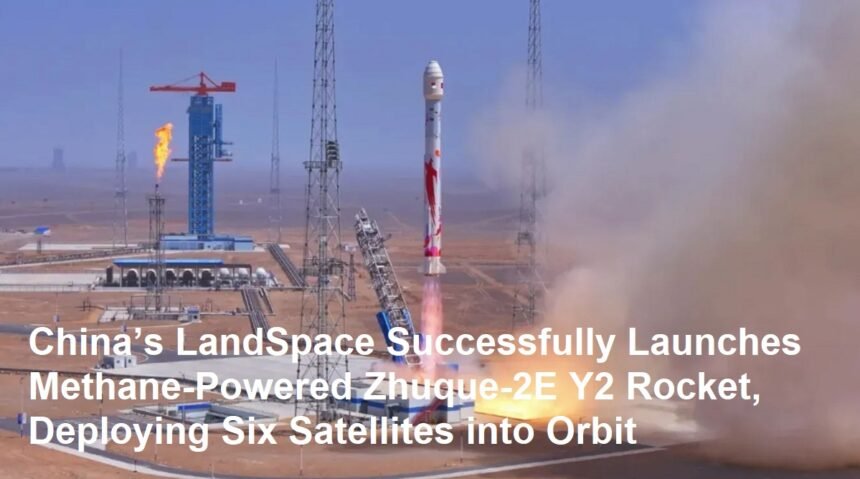On May 17, 2025, China’s private aerospace company LandSpace Technology achieved a significant milestone by successfully launching its methane-powered Zhuque-2E Y2 rocket, which carried six satellites into orbit. The launch took place at 12:12 p.m. local time from the Dongfeng Commercial Space Innovation Test Area near the Jiuquan Satellite Launch Center in northwest China. This mission marks the fifth flight of the Zhuque-2 series and highlights China’s growing capabilities in commercial space technology and reusable rocket development.
The Zhuque-2E Y2 rocket is an advanced variant of the Zhuque-2 series, featuring several technical improvements over its predecessors. Notably, it uses a dual-cryogenic liquid propellant system powered by liquid oxygen and methane, a combination that offers several advantages. Methane as a rocket fuel is gaining popularity worldwide due to its cost efficiency, cleaner combustion with lower emissions, and suitability for reusable rocket engines. LandSpace was the first company globally to launch a methane-liquid oxygen rocket back in July 2023, and this latest launch further cements its pioneering role in this technology.
One of the key innovations in the Zhuque-2E Y2 model is the deployment of a propulsion method that chills both liquid oxygen and methane below their boiling points, which significantly boosts engine thrust and efficiency. The rocket is powered by four TQ-12 engines on the first stage, each producing 80 tons of thrust, and a single TQ-15A engine on the second stage with 85 tons of thrust. The second stage engine also features a niobium-tungsten alloy extended nozzle, enhancing performance and durability.
This mission successfully deployed six satellites developed primarily by the Chinese commercial satellite maker Spacety. The payload included a diverse set of satellites: a radar satellite capable of all-weather, day-and-night imaging and detecting millimeter-scale surface shifts; two multispectral satellites dedicated to environmental monitoring and mineral exploration; and three satellites designed for scientific experiments supporting China’s deep-space exploration ambitions. The satellites ranged in weight from 20 to 300 kilograms, reflecting a versatile payload capacity.
The Zhuque-2E Y2 rocket can deliver up to 4,000 kilograms to a 500-kilometer sun-synchronous orbit, making it a competitive option for commercial satellite launches. This capability is crucial as China’s commercial space industry continues to expand rapidly, with increasing demand for satellite deployment for communications, earth observation, and scientific research.
LandSpace’s founder and CEO, Zhang Changwu, has announced that the company is actively developing reusable rocket technology, with plans to conduct a test launch of a reusable rocket in the second half of 2025. The technical improvements in the Zhuque-2E Y2, including the use of composite materials in the rocket’s fairing to replace metals, are part of the company’s strategy to enhance efficiency, reduce costs, and achieve reusability.
The successful launch of the Zhuque-2E Y2 rocket not only demonstrates China’s technological progress in methane-fueled rocketry but also signals the country’s ambition to become a major player in the global commercial space market. The use of methane as a propellant aligns with international trends toward more sustainable and cost-effective space launch solutions.
In summary, the May 17, 2025 launch of the Zhuque-2E Y2 rocket by LandSpace Technology represents a landmark achievement in China’s space industry. By deploying six satellites with a cutting-edge methane-powered rocket, LandSpace has showcased its innovation, technical prowess, and commitment to advancing reusable rocket technology. This mission contributes to China’s broader goals of expanding its commercial space capabilities and supporting scientific exploration, positioning the country as a leader in the next generation of space technology.









